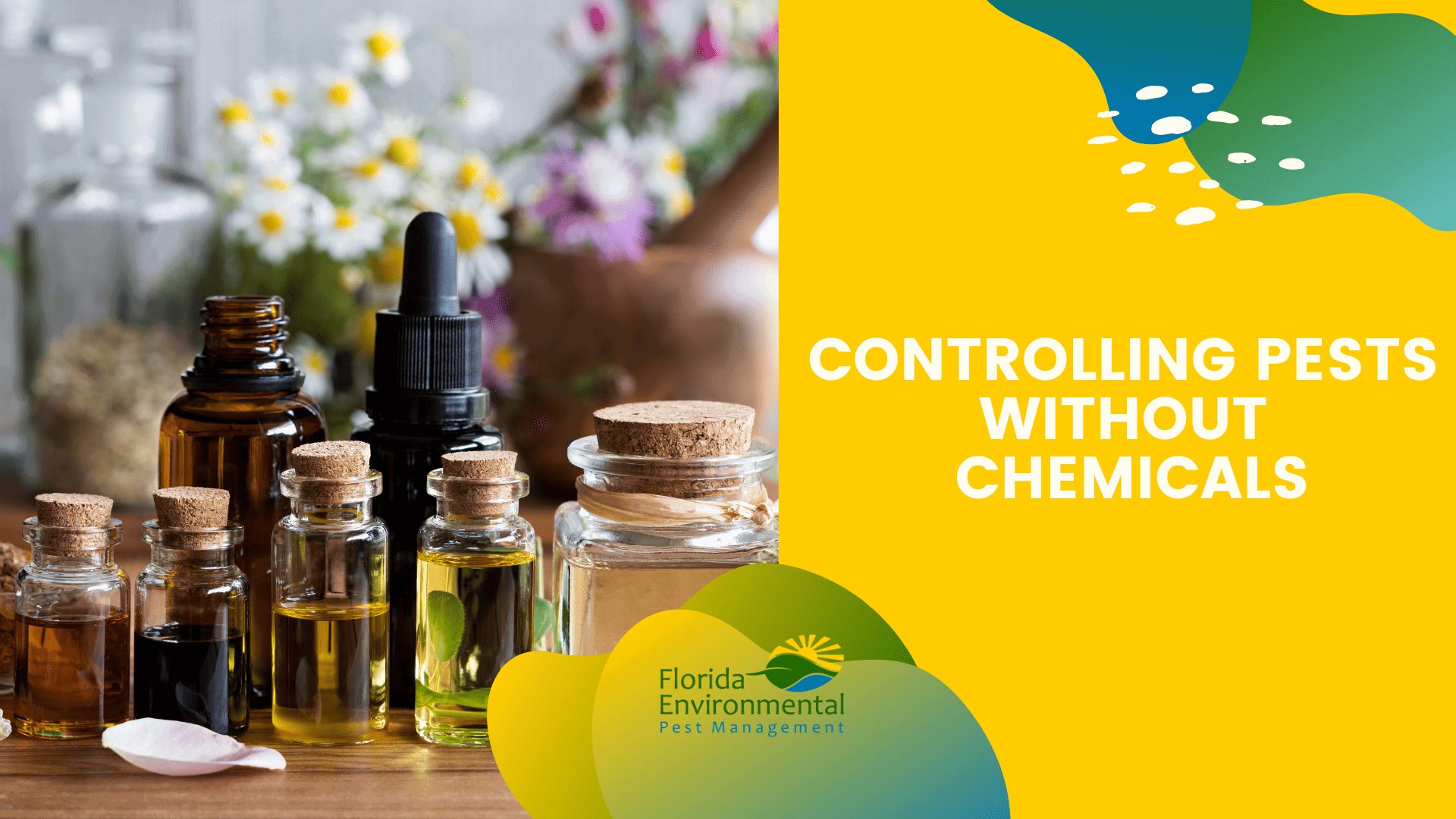Nothing compares to the peace of mind you enjoy when you live in a pest-free home. You don’t have to worry about getting bitten by snake, getting infected with diseases caused by vector pests like ticks, or constantly check your pantry for signs of pest activity. If you do have pests in your home, chances are you have tried to eliminate them using over-the-counter pesticides that promise to kill them all in one spray. First of all, those claims are not true, and secondly, those pesticides are made using chemicals that are harmful for your immune system and the environment.
While trying to solve one problem, you shouldn’t have to create another more destructive one. This is why it’s good to know that there are tons of chemical-free pest control methods that can be just as effective, like pesticide soaps, traps, and many other natural repellents that will be discussed in this article.
Natural Repellents For Pests
Here is a list of natural pest repellents, such as essential oils, vinegar, and herbs, and how to use them.
1. Peppermint oil
This essential oil effectively repels ants, spiders, and mice. To use it, mix 10-15 drops of peppermint oil with 1 cup of water and spray it around windows, doors, and other entry points.
2. Garlic
Garlic is a natural insecticide and is effective in repelling pests like aphids, mosquitoes, and cabbage worms. To use it, crush some garlic cloves and mix them with water, then spray the solution onto plants or around the area where pests are present.
3. Eucalyptus oil
This essential oil effectively repels mosquitoes, pantry moths, mice, and other insects. To use it, mix a few drops of eucalyptus oil with a carrier oil, such as olive or coconut oil, and apply it to the skin. To keep moths out, you should dip a cotton ball in the mixture and store it in your cabinet or wherever you find the moths.
4. Vinegar
Vinegar is a natural insecticide and is effective in repelling ants, fruit flies, and other pests. To use it, mix equal parts of vinegar and water and spray the solution around areas where pests are present.
5. Citronella
Citronella is a natural mosquito repellent and is commonly used in candles, but it can also be applied topically as an essential oil. Mix a few drops of citronella oil with a carrier oil and apply the mixture to the skin.
6. Basil
Basil is effective in repelling flies and mosquitoes. Plant basil around the garden or in pots around the house to use it. More than just acting as pest repellents, they will also be a beautiful addition to your garden and home.
7. Lavender
Lavender repels many insects, including mosquitoes, flies, and moths. The best part is that they have a pleasing, calming fragrance that you will enjoy. To use it, plant lavender around the garden or in pots around the house, or use a lavender essential oil spray.
8. Neem oil
Neem oil effectively repels many pests, including mosquitoes, ants, and bed bugs. To use it, mix a few drops of neem oil with a carrier oil and apply it to the skin or mix it with water and spray it around the house.
To use these natural pest repellents, you can mix them with water or carrier oils, apply them to the skin, or spray them around the house or garden. It’s important to note that natural pest repellents may not be as effective as chemical pesticides and may need to be reapplied more frequently.
Traps For Pests
Here are some common types of pest traps, along with a brief explanation of how to use them:
1. Glue Traps
These are flat cardboard or plastic sheets coated with a sticky adhesive. Place the traps near the areas where you’ve noticed pest activity, and discard them once they’re covered in pests.
2. Snap Traps
These small, spring-loaded traps are designed to kill pests like mice or rats quickly. Bait the traps with food like peanut butter or cheese, and place them along walls or in areas where you’ve noticed pest activity. Check the traps regularly and dispose of any dead pests.
This trap is dangerous to use and may cause injury if mismanaged. Ensure to keep it out of children’s reach and notify other adults of your use of them and where they are placed to prevent accidents.
3. Live Traps
These are traps designed to catch and hold pests like mice or squirrels without harming them. Bait the traps with food like peanut butter or nuts, and place them along walls or in areas where you’ve noticed pest activity. Once a pest is trapped, carefully remove the trap and release the pest far away from your home.
4. Ultrasonic Traps
These electronic devices emit high-frequency sound waves that are supposed to repel pests. Simply plug the device into an electrical outlet and allow it to emit sound waves. Remember that ultrasonic traps’ effectiveness is debated, and may not be effective for all types of pests.
5. Fly Traps
These are traps designed to catch and kill flies and other flying insects. Some fly traps use a sticky adhesive to catch the flies, while others use bait or UV light to attract the pests. Hang the trap in areas where you’ve noticed fly activity, and dispose of the trap once it’s filled with trapped pests.
6. Pheromone Traps
These traps attract pests like moths or beetles using specific pheromones. They are typically sticky and have a lure that contains the pheromones. Place the traps in areas where you’ve noticed pest activity, and dispose of them once they’re covered in pests.
It’s essential to follow the instructions carefully when using any type of pest trap. Ensure the trap is placed in the right location and appropriately baited, and check the trap regularly to dispose of any pests caught. Protecting pets and children from the traps is essential to avoid accidental injury.
Physical Barriers For Flying And Crawling Pests
Physical barriers are a preventive measure you must take to avoid an infestation. If you work with a professional pest control company, they may help you install one of these or advise you on how to do it.
1. Screens
Screens are used to keep out flying insects like mosquitoes, flies, and moths. They can be installed on windows and doors and are made from materials like fiberglass, aluminum, or stainless steel. To install a screen, measure the size of your window or door frame and cut the screen to fit. Then, use a spline roller to press the screen into the frame and secure it with clips or screws.
2. Caulking
Caulking is a sealant used to fill gaps and cracks around windows, doors, and other areas where pests can enter. To install the caulk, first clean the area where you want to apply it and let it dry completely. Then, use a caulking gun to apply a steady stream of caulk to the gap or crack. Smooth the caulk with a caulking tool or your finger, and let it dry completely before painting or applying any other finish.
3. Mesh
Mesh can be used to block pests from entering small openings like vents, crawl spaces, and gutters. It is typically made from metal or plastic and comes in various sizes and strengths. To install the mesh, measure the opening size and cut the mesh to fit. Then, use a staple gun or screws to secure the mesh to the opening.
4. Door sweeps
These are used to block pests from entering under doors. They are typically made from rubber or vinyl and are easy to install. To install a door sweep, measure the width of your door and cut the sweep to fit. Then, attach it to the bottom of the door with screws or adhesive.
5. Weatherstripping
Weatherstripping seals gaps around doors and windows to prevent pests from entering. It is typically made from rubber, foam, or felt and comes in various shapes and sizes. To install weatherstripping, clean the area where you want to apply it and let it dry completely. Then, cut the weatherstripping to fit the gap and attach it with adhesive or nails.
These physical barriers prevent pests from entering your home or building. It is vital to install them properly and ensure no gaps or openings where pests can still get in.
Biological Pest Control
Biological pest control methods are an eco-friendly and sustainable approach to managing pests that relies on natural enemies such as predators or parasites to control pest populations. Here are some standard biological pest control methods and how to use them:
1. Introducing predators
Predators are organisms that hunt and feed on other organisms. Introducing predators such as ladybugs, lacewings, and predatory mites can effectively control pest populations. These predators can be purchased from biological control suppliers and released in infested areas. However, it’s crucial to ensure that the predators are compatible with the pest species and the environment before introducing them.
2. Introducing parasitoids
Parasitoids are insects that lay their eggs inside or on their host’s body, hatching and feeding on the host, eventually killing it. Introducing parasitoids such as wasps and flies can effectively control pests such as aphids and caterpillars. These parasitoids can be purchased from biological control suppliers and released in the infested area.
3. Use of pheromones
Pheromones are chemicals that animals use to communicate with each other. Using synthetic pheromones can disrupt the mating behavior of pests such as moths and beetles, reducing the number of offspring produced. This method is particularly useful in agricultural settings.
4. Use of bacteria and fungi
Certain bacteria and fungi can be used to control pests such as caterpillars and mites. These microorganisms can be applied as sprays or powders to infested plants. Once the pests ingest the bacteria or fungi, they become infected and die.
Integrated Pest Management (IPM)
Integrated pest management (IPM) is a holistic approach to pest control that aims to manage pests by combining biological, mechanical, cultural, and chemical methods. The goal of IPM is to minimize the use of pesticides and reduce the impact of pest control practices on the environment while still effectively managing pest populations.
Follow these steps to use IPM in the home or garden:
- Identify the pest: Before taking any action, it’s crucial to accurately identify the pest in question. This will help you determine the best course of action.
- Monitor and assess: Regularly monitor your home or garden for signs of pest activity. This could include looking for pest damage, checking traps, or using sticky traps to capture insects.
- Set action thresholds: Determine when pest populations become problematic and require action.
- Utilize cultural and mechanical controls: These are non-chemical pest control methods, such as removing pest habitat, using physical barriers, and practicing good sanitation.
- Use biological controls: These are natural enemies of pests, such as predators, parasites, and pathogens. They can be introduced into the environment to help control pest populations.
- Use pesticides as a last resort: If other methods of control are ineffective, pesticides can be used. However, using them only as a last resort and following label instructions carefully are essential.
- Evaluate the effectiveness of the control measures: Regularly assess the effectiveness of the control measures being used to determine if they are working or if adjustments need to be made.
By following these steps, you can effectively manage pests in your home or garden while minimizing environmental impact.
DIY Methods
Many of the pest control methods mentioned above are DIY-friendly. However, you may not achieve the desired result if you are not an expert at fishing out pests, infiltrating their habitat, and exterminating them. There are benefits and risks involved with DIY pest control, and it is crucial to weigh both sides of the scale and consider whether DIY is the way to go.
Benefits of DIY pest control
- Cost-effectiveness: One of the main perceived benefits of DIY pest control is that it costs less to do than hiring a professional pest control service. With some research, you can find affordable and effective products to help you tackle your pest problem. However, if you get it wrong, you may have to continually repeat the process, leading to more expenses.
- Convenience: DIY allows you to choose when you want to take care of the pest control business. You don’t have to worry about canceling appointments or staying around the house while waiting for the pest control company to finish their job. However, this should not be a problem if you choose a convenient date for the company.
- Familiarity with your home: When you tackle pest control yourself, you become more familiar with the layout and structure of your home. This can help you identify potential problem areas and take steps to prevent future infestations.
- Greater satisfaction: Successfully removing pests on your own can be rewarding and give you a sense of accomplishment. You’ll feel more connected to your home and more confident in solving problems. However, it is not very likely that DIY methods can completely rid your home of these pests unless you are an expert using the right tools and materials.
- Control over the process: When you handle pest control yourself, you have more control over the process. You can take as much time as you need, use the methods you prefer, and tailor your approach to the specific pests you’re dealing with.
- More environmentally-friendly options: Many DIY pest control methods are environmentally friendly and don’t harm beneficial insects or pollinators. This can be a great option if you’re concerned about the impact of pesticides on the environment. However, with an experienced company by your side, you don’t have to worry about this, as they will ensure the use of the right products.
Risks of DIY pest control
- Ineffective treatment: As much as you may find dead insects or rodents on the ground after going DIY, there is a high chance that you haven’t completely removed the pests. A pest control expert will locate the source and exterminate the pests from there to prevent a re-infestation.
- Health risks: Many DIY pest control products contain toxic chemicals that can harm humans, pets, and the environment. Only trained experts are advised to use some of the pesticides and only as a last resort.
- Property damage: Most of the pest control products you will find in stores are made using harsh chemicals that promise quick action. Aside from their effects on your health, they can damage your surfaces, clothes, and more. This can lead to more expenses for repairs.
- Pesticide resistance: A prolonged use of any kind of pesticide will result in a resistance from pests. You may succeed in exterminating the present ones you find but may not be able to successfully kill their offspring in later attempts.
- Misidentification of pests: Several pests look alike and require different pest control methods. Although most pesticides promise to kill all kinds of crawling and flying insects, most of them are less effective against specific pests. Also, certain rodents require a different pest control approach, and you may wonder why you haven’t been able to get rid of the lawn digger after all your efforts. This may be due to misidentification and using the wrong control methods.
- Unforeseen consequences: DIY pest control can have unforeseen consequences, such as attracting other pests or contaminating food and water sources.
- Legal issues: Using certain types of pest control products may be illegal in some states if you do not have a license, and misusing them could lead to legal issues. By working with a pest control expert, you are sure to be in accordance with your state’s jurisdiction.
- Lack of expertise: Without proper training and knowledge, DIY pest control methods may not be as effective as those used by professional pest control services.
- Cost: DIY pest control may seem like a cost-effective option initially, but the costs could quickly increase if the problem persists or property damage occurs. You would save more by doing it correctly the first time; the only way to guarantee that is to work with an expert.
Chemical Free Solutions
Controlling pests without chemicals offers numerous benefits for human health and the environment. One primary benefit of non-chemical pest control methods is that they are generally safer for humans and pets. Chemical pesticides can cause a range of health problems, including skin irritation, respiratory issues, and even cancer in some cases. In addition, many chemicals used in pesticides can persist in the environment and accumulate in the food chain, potentially causing long-term harm to wildlife and humans alike.
By using alternative methods such as integrated pest management (IPM), biological controls, and physical barriers, we can effectively reduce the pest population without resorting to toxic chemicals that can negatively impact our health and the ecosystem. For professional chemical free pest control and maintenance services, contact Florida Environmental Pest Management today.





